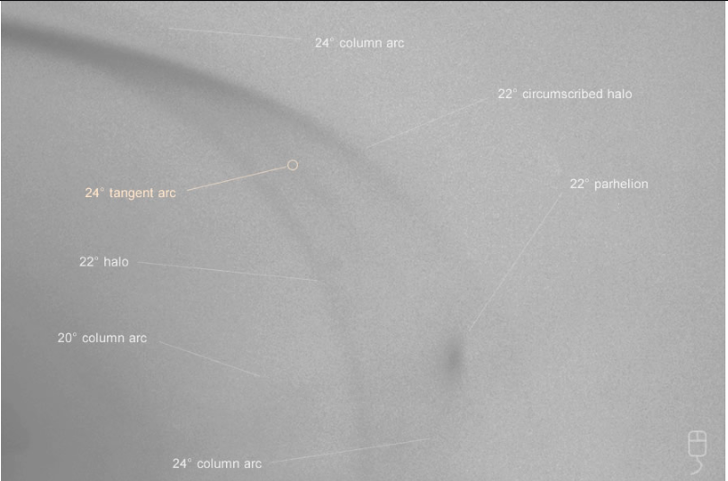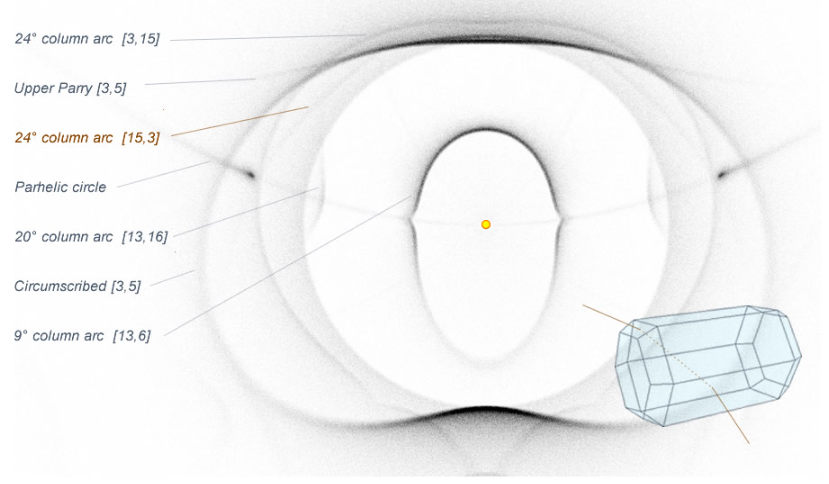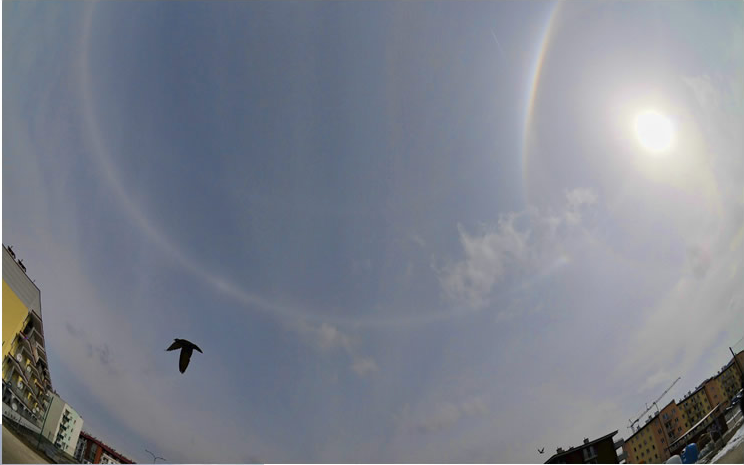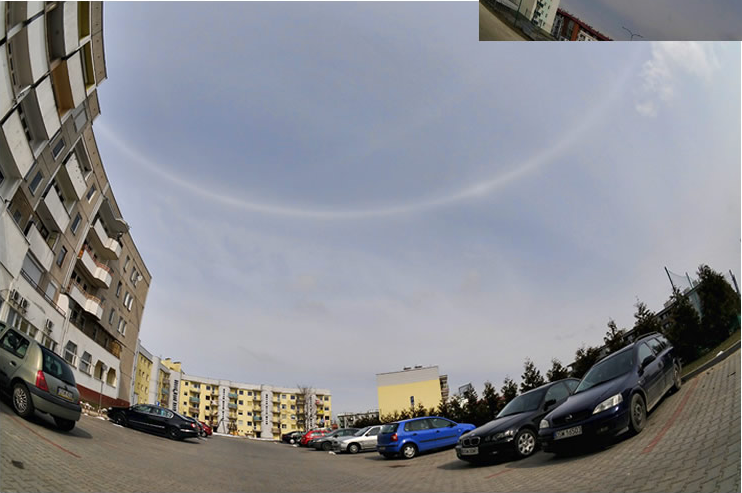OPOD - Rare 24° pyramidal column arcs
OPOD - Rare 24° Pyramidal Column Arcs
Have you ever witnessed a truly exceptional atmospheric optics phenomenon? Radek Grochowski had the privilege of experiencing a long-lasting and complex halo display in Świdnica, Poland on March 25, 2013. The images captured during this event were remarkable, but what made it even more extraordinary was the sighting of a third halo arc that appeared between the familiar 22-degree halo and the circumscribed halo. This additional arc was identified by Marko Riikonen as a very rare occurrence known as a pyramidal column arc, where horizontal column crystals with pyramidal ends create a unique optical effect in the sky.
Pyramidal crystals, which typically have aerodynamically rounded forms, are not commonly oriented. However, on rare occasions, they can take on plate orientations, resulting in a variety of parhelia, or plate arcs. Even more infrequently, they align as horizontal columns, as observed in Radek's photographs taken in Poland. The pyramidal ends of these crystals are significantly truncated, making them more prone to precise horizontal alignments.
Upon closer examination of the enhanced image, it became evident that Radek's photograph contained traces of other non-visible pyramidal column arcs. This discovery added an extra layer of fascination to an already extraordinary sighting. Through ray tracing simulations, researchers attempted to modify the crystal shapes to eliminate these non-visible arcs, only to find that the enhancement revealed their presence anyway. Radek's image turned out to be a treasure trove of pyramidal column arcs.
To better understand the formation of these rare arcs, ray tracing was conducted using pyramidal crystals aligned as singly oriented columns. The simulation showed that randomly oriented columns produced the more commonly observed 22-degree halo, while a few plate and Parry crystals completed the mix of optical phenomena. The ray paths in the simulation utilized specific face numbers of the pyramidal crystals, highlighting their impact on the resulting halo arcs.
Pyramidal arcs, as the name suggests, are named after the related odd-radius halo that would be generated if the crystals were randomly oriented. It is important to note that all column arcs, including pyramidal column arcs, are contact arcs, meaning they touch and are tangent to their related odd-radius circular halo at some point. The appearance of these arcs adds a touch of enchantment to the already captivating halo display.
While Radek's sighting of the rare 24-degree pyramidal column arcs was truly remarkable, it would have been even more delightful to witness the 9-degree column arc as well. Unfortunately, it is believed that this particular arc was likely melted by the sun's glare, leaving observers with just a tantalizing glimpse of its potential beauty.
The discovery of these pyramidal column arcs would not have been possible without the keen eyes and camera work of Radek Grochowski. Their sharp observation skills and willingness to share their findings have contributed to our understanding of these rare atmospheric phenomena. Special thanks also go to Marko Riikonen and Alec Jones for their valuable input and expertise.
If you're curious to see more images from Radek's sighting, take a look at the images below. They capture the full parhelic circle, 120-degree parhelia, 22-degree parhelia, Wegener arcs, circumscribed and 22-degree halos, all part of the mesmerizing halo display that preceded the appearance of the pyramidal crystal column arcs.
Remember, atmospheric optics never ceases to surprise us with its captivating and rare displays. Keep your eyes on the sky, for you never know what optical wonders might unfold before you.
Images ©Radek Grochowski, shown with permission.


An Exceptional Sighting
Radek Grochowski saw a long lasting complex halo display at Świdnica, Poland on March 25, 2013. Two images are below; but two hours after taking them he saw something exceptional. He saw a third halo arc improbably placed between the familiar 22 degree halo and circumscribed halo.
My thanks to Marko Riikonen for instantly recognising what it was. A very rare halo arc from horizontal column crystals with pyramidal rather than flat ends.
Pyramidal crystals mostly have aerodynamically rounded forms and therefore are not oriented. Rarely they take on plate orientations to give a variety of parhelia – plate arcs. Even more rarely they are oriented as horizontal columns. This took place over Radek’s Polish skies.
Mouse over the image at left for an enhanced view. It highlights coloured halos and so the white parhelic circle has gone. While attempting ray tracing simulations and before doing this enhancement I struggled to modify the crystal shapes to eliminate other non-visible pyramidal column arcs. Then the enhancement revealed traces of them anyway! Radek’s image has more than one gem.
The ray tracing at left for a 40° high sun used pyramidal crystals aligned as singly oriented columns. Randomly oriented columns produced the 22 degree halo and a few plate and Parry crystals completed the mix.
The pyramidal ends are severely truncated and these crystals would easily take on precise horizontal alignments. The ray paths in square brackets use the face numbers here.
Pyramidal arcs are named after the related odd radius halo that would be generated if the crystals were randomly oriented. All column arcs are contact arcs in that at some point they touch and are tangent to their related odd radius circular halo.
It would have been delightful to also see the 9° column arc as final icing on the cake but it was likely melted by the sun's glare.
My thanks to Marko Riikonen and Alec Jones for their input and for Radek Grochowski's sharp eyes and camera work.
Images ©Radek Grochowski, shown with permission.

The display two hours before the appearance of the pyramidal crystal column arcs.
There was a full parhelic circle, 120° parhelia, 22° parhelia, Wegener arcs, circumscribed and 22° halos.


Note: this article has been automatically converted from the old site and may not appear as intended. You can find the original article here.
Reference Atmospheric Optics
If you use any of the definitions, information, or data presented on Atmospheric Optics, please copy the link or reference below to properly credit us as the reference source. Thank you!
-
<a href="https://atoptics.co.uk/blog/opod-rare-24-pyramidal-column-arcs/">OPOD - Rare 24° pyramidal column arcs</a>
-
"OPOD - Rare 24° pyramidal column arcs". Atmospheric Optics. Accessed on November 21, 2024. https://atoptics.co.uk/blog/opod-rare-24-pyramidal-column-arcs/.
-
"OPOD - Rare 24° pyramidal column arcs". Atmospheric Optics, https://atoptics.co.uk/blog/opod-rare-24-pyramidal-column-arcs/. Accessed 21 November, 2024
-
OPOD - Rare 24° pyramidal column arcs. Atmospheric Optics. Retrieved from https://atoptics.co.uk/blog/opod-rare-24-pyramidal-column-arcs/.